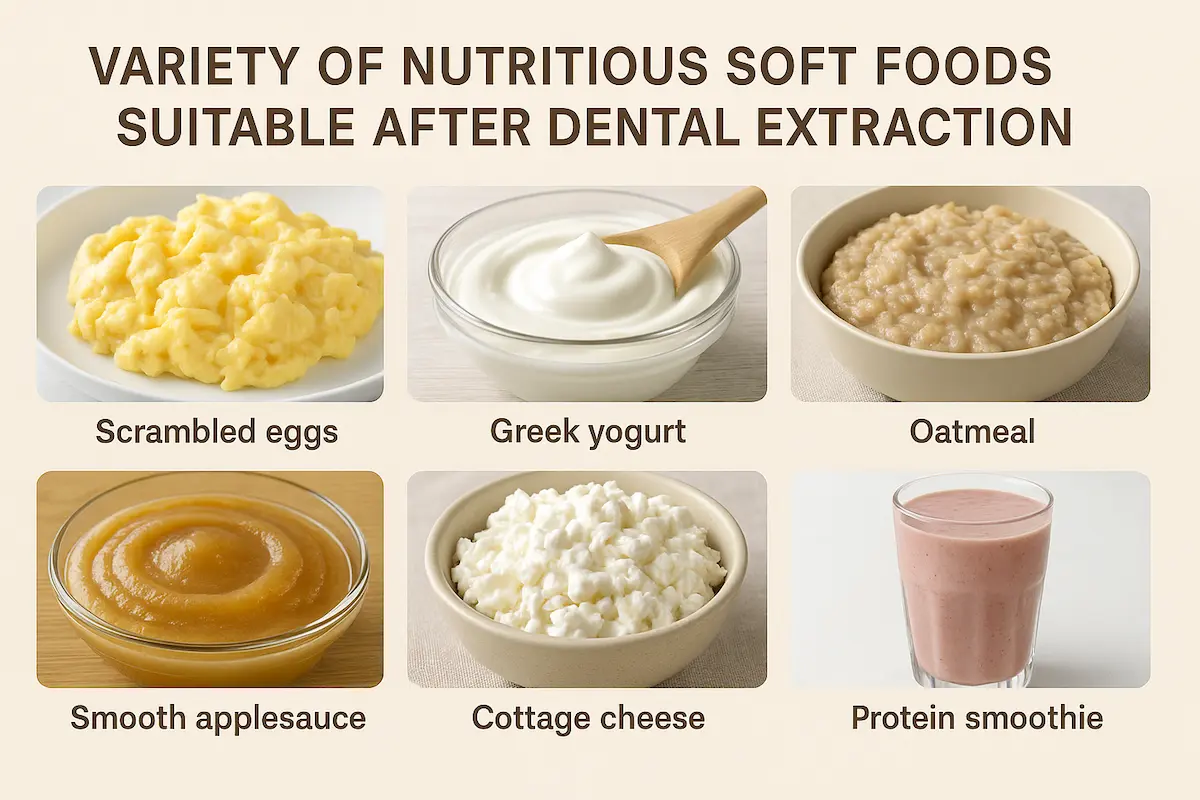Did you just have your tooth pulled and now trying to figure out what you can safely eat without disrupting your healing or causing pain? Many patients leave the dental office with brief instructions to "stick to soft foods," but few details about what that actually means for their next several meals. Creating a satisfying and nutritious menu while avoiding discomfort doesn't have to be frustrating or bland.
Why Soft Foods Matter After Extraction
The Healing Process
After a tooth extraction, your body forms a blood clot in the socket where your tooth once was. This clot acts as a protective layer over exposed bone and nerve endings, allowing new tissue to develop. Eating hard, crunchy, or chewy foods can dislodge this blood clot, leading to a painful condition called dry socket. Soft foods minimize the risk of disrupting this healing process.
Comfort and Pain Management
The area around an extraction site remains tender for several days. Chewing firm foods can create pressure and pain in the surgical area. Soft foods require minimal chewing effort, reducing discomfort during meals. Wondering when you can eat solid food after extraction, read more here
How Soft Foods Prevent Dry Socket
Beyond protecting the blood clot, soft foods help prevent other complications. They're less likely to leave behind particles that could become trapped in the socket, reducing infection risk. Smooth, cool foods can also help manage swelling and provide gentle comfort to irritated tissues around the extraction site.
proper nutrition plays a significant role in healing the wound after dental procedures. Protein and vitamin rich soft foods can help speed up recovery time and reduce discomfort during the healing process.
50 Soft Foods for Recovery
Breakfast Options
- Scrambled eggs (soft and fluffy)
- Greek yogurt (plain or with honey)
- Oatmeal (cooked until very soft)
- Cream of wheat
- Smooth applesauce
- Protein smoothie with banana and peanut butter
- Cottage cheese
- Ricotta cheese with mashed fruit
- Milk or yogurt-based fruit smoothies
- Pureed pumpkin with cinnamon and maple syrup
Easy to Eat Lunch and Dinner Ideas
- Mashed potatoes
- Sweet potato purée
- Butternut squash soup
- Tomato soup (not too hot)
- Cream of mushroom soup
- Well-cooked pasta with butter or soft sauce
- Macaroni and cheese (soft, not baked)
- Pureed vegetable soup
- Refried beans
- Hummus
- Soft cooked lentils
- Risotto (cooked until very soft)
- Egg salad (finely mashed)
- Tuna salad (mashed well)
- Chicken noodle soup (with small, soft noodles)
- Mashed avocado
- Soft tofu dishes
- Potato soup
- Vegetable purees
- Soft polenta

Nutritious soft food options that support healing after dental extraction
Soft Desserts and Snacks That Won't Hurt
- Pudding (chocolate, vanilla, or rice)
- Jell O or gelatin
- Ice cream (without nuts or candy pieces)
- Frozen yogurt (smooth varieties)
- Milkshakes (eaten with a spoon, not a straw)
- Soft, ripe banana
- Applesauce
- Soft fruit sorbet
- Custard
- Popsicles (helpful for reducing swelling)
Liquid and Soft Nutrition
- Protein shakes
- Meal replacement drinks
- Puréed fruit smoothies with added protein powder
- Bone broth
- Vegetable juice (non-acidic varieties)
- Ensure or Boost nutritional drinks
- Yogurt drinks
- Blended soups with added nutritional yeast
- Mashed banana with protein powder
- Puréed vegetable and bean soups
According to research published in the National Library of Medicine, adequate protein intake is particularly important during oral wound healing. Their studies show that patients who maintain proper nutrition recover more quickly and experience fewer complications after dental surgery.
Nutritional Considerations
Best Protein Sources When You Can't Chew
Healing tissues need protein to rebuild. After an extraction, focus on incorporating soft protein sources into your meals. Greek yogurt contains nearly twice the protein of regular yogurt. Eggs can be prepared in various soft ways. Protein smoothies offer concentrated nutrition that requires no chewing. Mashed beans, lentils, and soft tofu provide plant based protein options that support tissue repair.
How to Get Vitamins Without Raw Vegetables
Fruits and vegetables can be made extraction friendly through cooking, blending, or mashing. Applesauce, mashed bananas, and avocados need minimal preparation. For vegetables, consider puréed soups, well cooked and mashed carrots, squash, or peas. These provide essential nutrients without requiring significant chewing.
Calcium Rich Foods for Socket Healing
Calcium supports bone health, which becomes especially important after tooth extraction. Dairy products like yogurt, cottage cheese, and milk shakes provide readily available calcium. For those who avoid dairy, calcium fortified plant milks, pureed tofu, and well cooked and mashed calcium rich greens offer alternatives.
Medical professionals at the Cleveland Clinic recommend emphasizing nutrient dense soft foods rather than simply eating whatever soft foods are convenient. They highlight the importance of maintaining dietary balance even when food choices are limited by dental procedures.
Food Preparation Tips
Blending and Pureeing
A good blender or food processor can be valuable after dental extraction. Almost any nutritious food can be transformed into an soft post op friendly food. Try blending cooked vegetables with broth for instant soup, or fruit with yogurt for a nutritious smoothie. Cook vegetables until very soft before blending for the smoothest results.
Temperature Considerations
Very hot foods can disrupt blood clot formation and cause discomfort. Allow hot foods to cool to a warm temperature before eating. Cold foods like ice cream and yogurt can provide soothing relief to tender gums, but avoid extremely cold items if you experience temperature sensitivity after your extraction.
Seasoning Adjustments
Spicy seasonings can irritate the extraction site and cause discomfort. However, this doesn't mean your food must be bland. Herbs, mild spices, garlic, and small amounts of salt can enhance flavor without causing irritation. Avoid acidic ingredients like lemon juice or vinegar, which might sting the wound site.
Dental experts at Colgate Professional note that food choices play a significant role in preventing dry socket. They recommend maintaining a soft food diet for at least 24 hours after extraction, and longer for surgical extractions like wisdom tooth removal.
How to Return to Normal Foods
When to Start Eating Solid Foods Again
As healing progresses, you can gradually introduce slightly firmer foods. Begin with soft foods that require minimal chewing, then progress to foods requiring moderate chewing as comfort allows. Pay attention to how your extraction site feels after eating. If you experience increased pain, return to softer options for another day or two.
How Long Until You Can Eat Normally
Most patients can begin incorporating moderately firm foods after about 3-7 days, depending on the complexity of their extraction. Simple extractions generally heals faster than surgical ones. Your dentist will provide specific advice based on your case. Complete healing of the socket takes several weeks, but dietary restrictions typically ease well before healing is complete.
Why Healing Time Varies Between Induviduals
Everyone heals at different rate. Factors like age, overall health, extraction complexity, and whether you smoke can affect healing time. Listen to your body rather than following a rigid timeline. Some patients feel comfortable returning to normal foods within a few days, while others prefer to stick with soft options longer.
The Centers for Disease Control and Prevention reports that maintaining good nutrition supports overall oral health and healing after dental procedures. Their research indicates that patients who follow dietary recommendations after extractions typically experience fewer complications.
When to Contact Your Dentist
Pain When Eating
If you experience sharp or severe pain when attempting to eat even the softest foods, contact your dentist. This might indicate a complication like dry socket or infection that requires treatment. Normal discomfort should gradually improve, not worsen, in the days following extraction.
How to Recognize Nutritional Deficiencies
If you find yourself unable to consume adequate nutrition due to pain or other limitations, reach out to your dental provider. They may recommend additional pain management strategies or provide further dietary guidance to ensure proper healing.
Wrap up
Regular dental check-ups can help identify potential issues before they require extraction. For those who need extractions, our team provides comprehensive restorative dental care with personalized post-procedure guidance.
If you've recently had a tooth extraction or are preparing for one, contact our dental team for specific dietary recommendations tailored to your situation. We can help ensure your recovery proceeds smoothly with proper nutrition that supports healing while maintaining your comfort.





